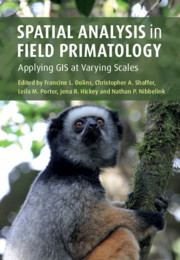Book contents
- Spatial Analysis in Field Primatology
- Spatial Analysis in Field Primatology
- Copyright page
- Dedication
- Contents
- Contributors
- Acknowledgments
- 1 Why Place Matters, and its Use in Primate Behavioral and Ecological Research
- Part I GPS for Primatologists
- Introduction
- 2 Fundamentals of GIS and GPS
- 3 “Next-Gen” Tracking in Primatology
- 4 The Ethical Implications, and Practical Consequences, of Attaching Remote Telemetry Apparatus to Macaques
- 5 Processing Geospatial Data in R
- 6 Estimating Travel Distance and Linearity of Primate Routes
- Part II GIS Analysis in Fine-Scale Space
- Part III GIS Analysis in Broad-Scale Space
- Index
- Plate Section (PDF Only)
- References
5 - Processing Geospatial Data in R
A Primer
from Part I - GPS for Primatologists
Published online by Cambridge University Press: 29 January 2021
- Spatial Analysis in Field Primatology
- Spatial Analysis in Field Primatology
- Copyright page
- Dedication
- Contents
- Contributors
- Acknowledgments
- 1 Why Place Matters, and its Use in Primate Behavioral and Ecological Research
- Part I GPS for Primatologists
- Introduction
- 2 Fundamentals of GIS and GPS
- 3 “Next-Gen” Tracking in Primatology
- 4 The Ethical Implications, and Practical Consequences, of Attaching Remote Telemetry Apparatus to Macaques
- 5 Processing Geospatial Data in R
- 6 Estimating Travel Distance and Linearity of Primate Routes
- Part II GIS Analysis in Fine-Scale Space
- Part III GIS Analysis in Broad-Scale Space
- Index
- Plate Section (PDF Only)
- References
Summary
Geospatial data are inherently rich and complex, often consisting of large databases and complicated file structures. These data are frequently used to study primate resource use (e.g., Coleman & Hill 2014), social group formation and maintenance (e.g., Qi et al. 2014), and disease transmission (Springer et al. 2016), among many relevant topics. Geospatial data commonly take the form of movement tracks resulting from a researcher following an animal or group of animals and recording their location using handheld GPS units (e.g., Howard et al. 2015; Janmaat et al. 2013; Chapter 6). These movement tracks may also be recorded by GPS tags placed on individual animals (e.g., Patzelt et al. 2014; Chapters 3 and 4). Geospatial data may also result from researchers walking transects to survey primate occurrence (e.g., Araldi et al. 2014; Hicks et al. 2014). This type of data are composed of location coordinates (e.g., the track the primate or the researcher walked) and attribute data, such as time, observed behaviors, or unique identifiers for individuals. Raster and vector areal data (see the section Raster Data) that characterize landscapes of interest also make significant contributions to the study of primatology (e.g., Szantoi et al. 2017). Due to the richness and complexity of geospatial data, automated processing is advantageous, as it reduces processing time and reduces the chance of user error, compared to manual editing.
- Type
- Chapter
- Information
- Spatial Analysis in Field PrimatologyApplying GIS at Varying Scales, pp. 87 - 105Publisher: Cambridge University PressPrint publication year: 2021



